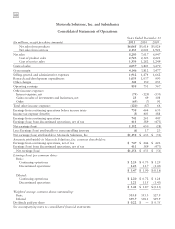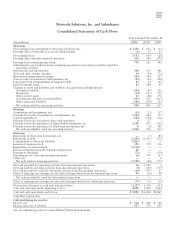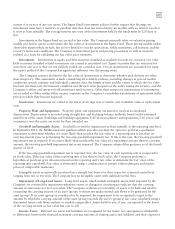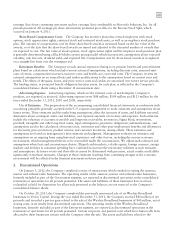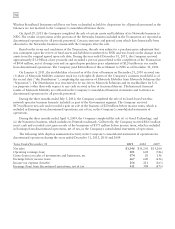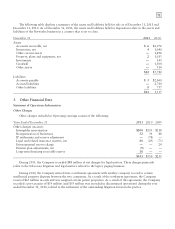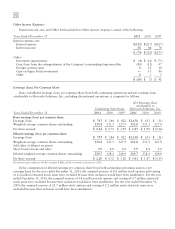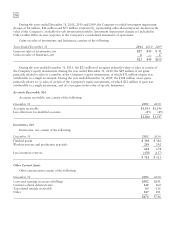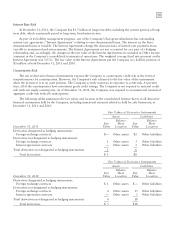Motorola 2011 Annual Report Download - page 75
Download and view the complete annual report
Please find page 75 of the 2011 Motorola annual report below. You can navigate through the pages in the report by either clicking on the pages listed below, or by using the keyword search tool below to find specific information within the annual report.
69
earnings (loss) from continuing operations and net earnings (loss) attributable to Motorola Solutions, Inc. for all
periods presented. All earnings per share information presented gives effect to the Reverse Stock Split, which
occurred on January 4, 2011.
Share-Based Compensation Costs: The Company has incentive plans that reward employees with stock
options, stock appreciation rights, restricted stock and restricted stock units, as well as an employee stock purchase
plan. The amount of compensation cost for these share-based awards is measured based on the fair value of the
awards, as of the date that the share-based awards are issued and adjusted to the estimated number of awards that
are expected to vest. The fair value of stock options, stock appreciation rights and the employee stock purchase plan
is generally determined using a Black-Scholes option pricing model which incorporates assumptions about expected
volatility, risk free rate, dividend yield, and expected life. Compensation cost for share-based awards is recognized
on a straight-line basis over the vesting period.
Retirement Benefits: The Company records annual expenses relating to its pension benefit and postretirement
plans based on calculations which include various actuarial assumptions, including discount rates, assumed asset
rates of return, compensation increases, turnover rates and health care cost trend rates. The Company reviews its
actuarial assumptions on an annual basis and makes modifications to the assumptions based on current rates and
trends. The effects of the gains, losses, and prior service costs and credits are amortized over future service periods.
The funding status, or projected benefit obligation less plan assets, for each plan, is reflected in the Company’s
consolidated balance sheets using a December 31 measurement date.
Advertising Expense: Advertising expenses, which are the external costs of marketing the Company’s
products, are expensed as incurred. Advertising expenses were $98 million, $109 million and $123 million for the
years ended December 31, 2011, 2010 and 2009, respectively.
Use of Estimates: The preparation of the accompanying consolidated financial statements in conformity with
accounting principles generally accepted in the U.S. requires management to make estimates and assumptions about
future events. These estimates and the underlying assumptions affect the amounts of assets and liabilities reported,
disclosures about contingent assets and liabilities, and reported amounts of revenues and expenses. Such estimates
include the valuation of accounts receivable and long term receivables, inventories, Sigma Fund, investments,
goodwill, intangible and other long-lived assets, legal contingencies, guarantee obligations, indemnifications, and
assumptions used in the calculation of income taxes, retirement and other post-employment benefits and allowances
for discounts, price protection, product returns, and customer incentives, among others. These estimates and
assumptions are based on management’s best estimates and judgment. Management evaluates its estimates and
assumptions on an ongoing basis using historical experience and other factors, including the current economic
environment, which management believes to be reasonable under the circumstances. We adjust such estimates and
assumptions when facts and circumstances dictate. Illiquid credit markets, volatile equity, foreign currency, energy
markets and declines in consumer spending have combined to increase the uncertainty inherent in such estimates
and assumptions. As future events and their effects cannot be determined with precision, actual results could differ
significantly from these estimates. Changes in those estimates resulting from continuing changes in the economic
environment will be reflected in the financial statements in future periods.
2. Discontinued Operations
On January 1, 2012, the Company completed a series of transactions which resulted in exiting the amateur,
marine and airband radio businesses. The operating results of the amateur, marine and airband radio businesses,
formerly included as part of the Government segment, are reported as discontinued operations in the consolidated
statements of operations for all periods presented. The assets and liabilities of these businesses have not been
reclassified as held for disposition for all periods presented as the balances are not material to the Company’s
consolidated balance sheets.
On October 28, 2011, the Company completed the previously announced sale of its Wireless Broadband
businesses to Vector Capital. During the year ended December 31, 2011, the Company received $80 million of net
proceeds and recorded a pre-tax gain related to the sale of the Wireless Broadband businesses of $40 million, net of
closing costs, in its results from discontinued operations. The operating results of the Wireless Broadband
businesses, formerly included as part of the Enterprise segment, are reported as discontinued operations in the
statements of operations for all periods presented. Certain corporate and general costs which have historically been
allocated to these businesses remain with the Company after the sale. The assets and liabilities related to the



